Nihongo from Mihongo
What a pleasure it is to meet a like-minded person! That's how I feel about Dan Bornstein, a new digital friend and the creator of the impressive project Mihongo. The clever name changes the first kanji in 日本語 (にほんご: Japanese language) to 見 (み), to mean "seeing." Through photos and drawings of unusual items, this visual dictionary offers an extremely helpful way of grasping terms specific to Japan. And because Dan has a strong interest in traditional Japanese culture, many of the entries skew in that direction.
I feel the same attraction to old Japan—at least aesthetically—so I've had a great time browsing his entries, many of which delve into my favorite things, including Japanese scripts, architecture, and nature.
Dan has kindly given me permission to borrow his images so that I can present you with a series of matching games organized by those very themes.
I. Writing
In this first quiz, you need to match three things: a compound, a definition, and a picture.
| 1. 葦手書き (あしでがき) | a. stylized personal monogram |
| 2. 花押 (かおう) | b. formal headgear that court officials wore in ancient times |
| 3. 冠 (かんむり) | c. ink drawing in which the kanji and kana look like wild reeds |
i.

ii.
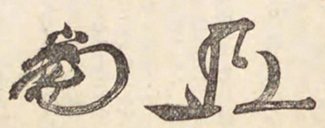
iii.
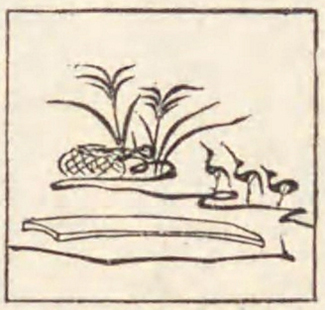
I'll block the answers with a preview of the newest essay:
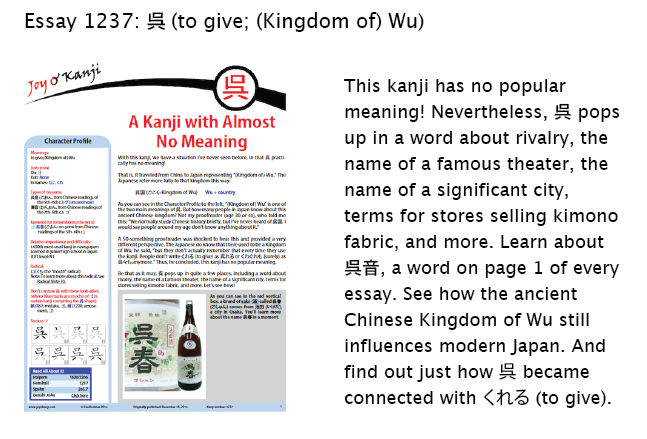
Okay, here are the answers:
1.c.iii. 葦手書き (あしでがき: ink drawing in which the kanji and kana look like wild reeds). The first kanji, the non-Joyo 葦, means "reed."
2.a.ii. 花押 (かおう: stylized personal monogram).
3.b.i. 冠 (かんむり: formal headgear that court officials wore in ancient times).
You may wonder why I included a hat in a section related to writing! I primarily associate 冠 with radicals at the top of a character, as with the "grass" radical that crowns 花 (flower). However, according to Halpern, 冠 originally represented things worn on the head, such as crowns or caps. Now, of course, the "grass" radical crowns the rest of the kanji!
II. Architecture
Match the compounds to the pictures. This time I'll make it harder by not presenting definitions.
| 1. 鰹木 (かつおぎ) | 4. 泉殿 (いずみどの) |
| 2. 火灯窓 (かとうまど) | 5. 山門 (さんもん) |
| 3. 唐門 (からもん) |
a.
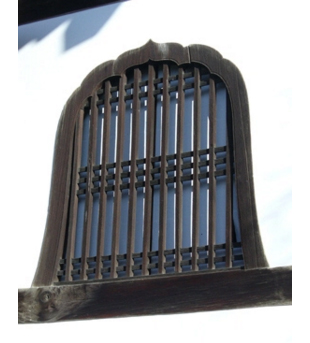
b.
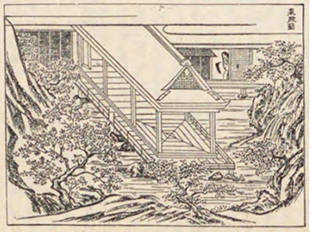
c.
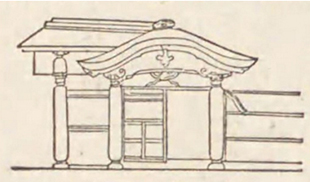
d.

e.
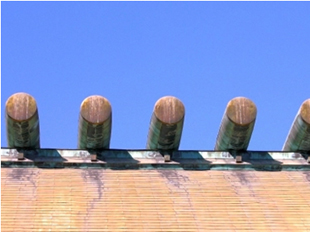
I'll block the answers with two architecture-related entries from Mihongo:
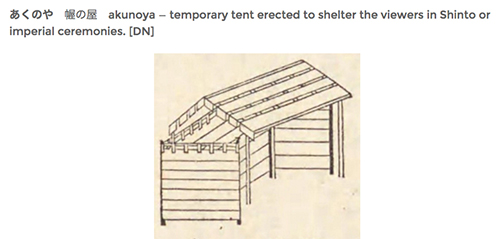
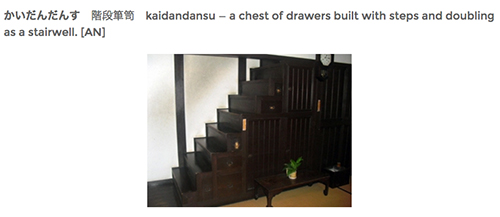
In the first image, I love the repetition of the 屋 shape inside 幄の屋. The non-Joyo 幄 means "curtain." The second image presents more doubling, not of a shape but rather of a function. There's also a duplicated だん sound at the heart of the word! I've seen and admired many step tansus but have never come across a whole flight of stairs doubling as a tansu!
By the way, "[DN]" means that the illustration comes from Dai Nihon Kokugo Jiten, and in case you're concerned about copyright violation, you needn't be. The copyright protection period for that old dictionary has ended, according to Japanese law. Meanwhile, "[AN]" pictures come from 足成, a site that offers pictures you can use for free.
Now for the answers:
1.e. 鰹木 (かつおぎ: type of fish + wood) are horizontal logs serving a decorative purpose in Shinto shrine architecture. The non-Joyo 鰹 (かつお) means "bonito," which English speakers call a skipjack tuna. Daijisen, Kojien, and Nihon Kokugo Dai-Jiten all explain the fish-log connection by saying that a 鰹木 looks like 鰹節 (かつおぶし: dried bonito). If you associate bonito with papery flakes, that will seem confusing. To understand, you need to know that the shavings come from a gutted fillet that has been smoked for up to a month, then sun-dried and fermented, seemingly turning into a piece of wood! Here's an image:
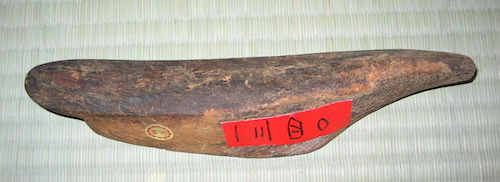
2.a. 火灯窓 (かとうまど: fire + lantern + window) is a type of window in Buddhist temples. Apparently, the shape of the window resembles that of a device people used for lighting in the olden days. Although it's labeled 瓦灯 (がとう) on the linked site, people also refer to this mechanism as 火灯.
3.c. 唐門 (からもん: Chinese + gate) is a Chinese-style gate with a curved gable.
4.b. 泉殿 (いずみどの: spring + house) is a structure built over a natural spring. With no walls, this structure affords easy access to the water.
5.d. 山門 (さんもん: mountain + gate) is the main gate at a Buddhist temple. As for the connection to mountains, many temples have not only a formal name but also a second name, known as the 山号 (さんごう: mountain name). Originally, the Japanese built temples in the mountains, which is how this practice began, but the 山号 custom persisted even after people started building temples on level ground. Not all temples have a 山号, though.
III. Nature
Let's do a final set, again without definitions!
| 1. 籠目 (かごめ) | 4. 稲株 (いなかぶ) |
| 2. 葛子 (かずらご) | 5. 砂紋 (さもん) |
| 3. 河童 (かっぱ) |
a.
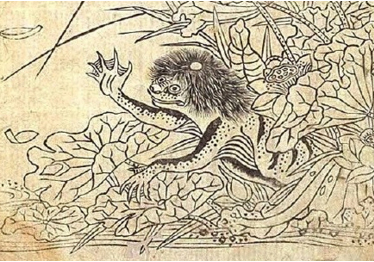
b.

c.
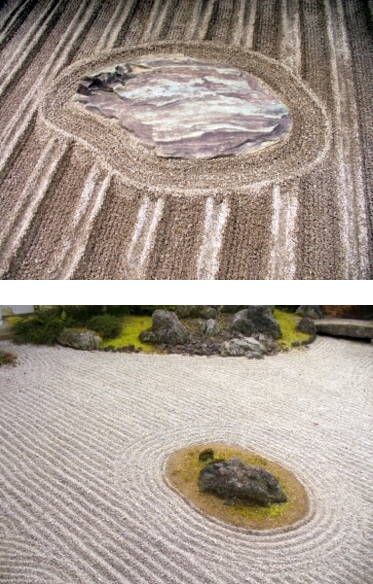
d. e.
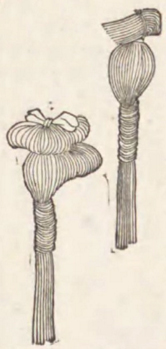
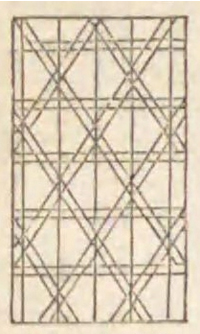
I'll block the answers with another great entry from Mihongo:

The word 一服 (いっぷく) means "a dose," and indeed the vendor offered only a sip of tea! There's truth in advertising, I suppose, but would it have killed him to offer at least a shot of tea?!
1.e. 籠目 (かごめ: basket + mesh, grid) is a type of pattern. Note the unexpected meaning of 目 here.
2.d. 葛子 (かずらご: kudzu + child) is a doll made of vines. But there's not a full doll in the picture, just styled hair! Kojien explains that children imagine the remaining parts of the body. People say that toys made kids use their imaginations more in the past, and in this case that's particularly true!
3.a. 河童 (かっぱ: river + child) is a mythological creature said to live in rivers, preying on land-dwelling people and animals when they enter the water.
Mihongo has included a second image of a 河童, and it's too adorable not to share:
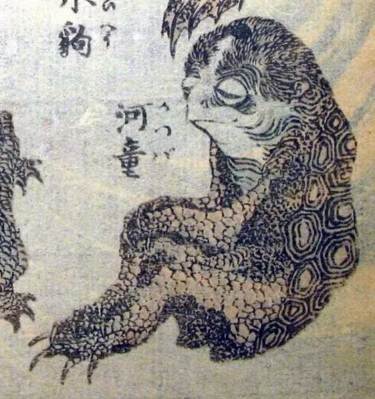
4.b. 稲株 (いなかぶ: rice plant + stubble) is the stubble left in the ground after ears of rice have been harvested.
5.c. 砂紋 (さもん: sand + pattern) refers to decorative patterns made by raking sand in Japanese gardens. The patterns suggest waves, ripples, streaming water, and so on. And the yomi makes me think of salmon, appropriately enough!
Joy o' Kanji is off for the holidays (though the newsletter is coming up in a few days). Happy holidays and Happy New Year!

Comments